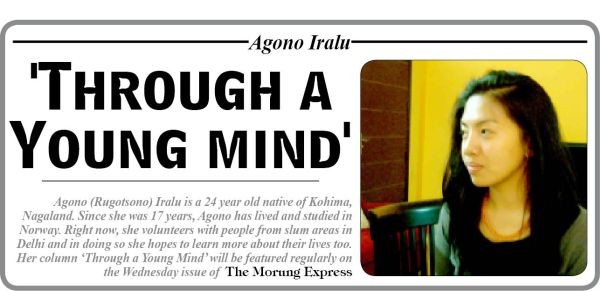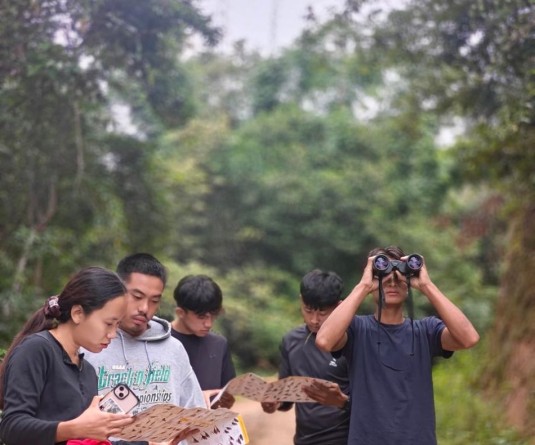
I recently went to the Eastern regions of Nagaland, for work and also to see the place. It’s embarrassing that I have travelled so little within Nagaland and that I do not know beyond, say, my tribe or the more urbanized regions of the state. I feel handicapped too because my knowledge and experience is confined only in a specified radius. If I know a Konyak I believe I would undoubtedly know a Konyak who is more Angami than he is a Konyak, and beyond that I may not have ventured to learn more. When asked all I know is Kohima and the Anglo upbringing I grew up in. Sometimes we are too confined in our realms not willing to look beyond our thresholds or those among us who venture out are too obscure, in a direction which cannot contextualize with our reality.
I took time to see, absorb and understand the culture, living conditions and even to experience Nagaland in a way I have never done before. There is something so diverse and yet rooted to an indigenous identity –the experience of Nagaland through one’s own eyes and senses than through books or mere narrations. Do we need this, you could ask? Do we nee to get to know one another better? Our history as a conscious collective entity began in the 1920s, but as neighbors or ethnic indigenous people, perhaps something like ‘time immemorial’.
It opens your eyes to travel and see, but also to learn and absorb our many different cultures. There is so much to learn even from ourselves –the diversity or versatility, perhaps its worth even more than running after a western-induced popular mass-culture! The Konyaks for example, were very intelligent and connoisseurs of almost every trade. They were the first among who learned how to make gun powder (no they didn’t learn it from the Chinese, I asked) and also to make guns. The British colonizers however, intimidated, introduced opium among the Konyaks like they did in China and this has badly affected the people. I wish one day we could appreciate this and look at it as even a capital, it is indeed something very unique that is overlooked quite easily by the ordinary eye.
Mon Town
After a twelve-hour long journey, coming to Mon felt like we reached the interiors of Nagaland, the other tip end of the state. But I was surprised to find that Mon town was equipped with all the entrapments of a ‘modern’ town, a large area stretching over some 7, 8 mountains I believe. It could have been mistaken for Kohima if one hadn’t known. But upon observation you came across pockets of poverty and upon closer observance the roads to the main town was pot-holed, some part of it being dragged away by the landslide. Water was scarce in town like Kohima during the dry seasons and when I went to draw water at the water-spot it was infested with mosquitoes. They said they don’t usually collect water from the water sources but that it comes through a pipeline. However that pipeline needs to be paid a little extra cash in order for it to work although water is usually always available in the pipes. These instances made me aware how modernity is often mistaken under the garbs of superficial modernity or exploitation. It is exploitation that I am more worried about because under modernity transnational companies spread their wings all across the north-east introducing consumerism and exploiting the local inhabitants. In the case of these more vulnerable areas that is more poignant, there are no roads but uncle chips and coca cola can be found in almost every store. You get company cigarettes or ‘Assam ka maal’, Hannah Montana tee shirts but no electricity for days and the newspaper is always a day or two late. Can you call that modern, can you call that development? This is what worries me, much more so in these vulnerable areas where outsiders can easily exploit the situation and if we, the more able, turn a blind eye what will happen?
Isn’t it part our responsibility too? Would we not benefit collectively from developing Mon, or Tuensang or Noklak? Or, should we think of Nagaland state minus Mon, Tuensang, Noklak, Longleng? If Kohima and Dimapur develop does that suffice for the rest of Nagaland state? I wonder if it is ignorance or our decision to ignore that makes us such contradictory human beings.
I ask that of every individual whether you are an Eastern Naga or a ‘forward’ tribe Naga, more so if you are holding a position of responsibility. I do not ask on behalf of the lesser privileged Nagas but I ask because they are a part of us, part of the state and part my, your responsibility too. I found out that tourism was one of the few avenues that they could make use for a livelihood but there again I was worried for the exploitation and negative influence of tourism. Yes, the tour guide agreed, some tourists were very difficult to handle. If the negative influences of tourism get the better of us, which in most cases happen, then it would a collective deterioration of the state.
I observed that there were some well-built RCC buildings in town which looked like private. On asking, some belonged to BDOs, secretaries, or higher ups who either lived in Kohima or Dimapur. Someone commented that there are some Konyaks who do well and then marry other tribes who are more ‘forward’. But more worrying was the developing class system in the community and that the living standard is very stretched between the poor and the rich. Once again the vulnerability, remoteness or isolation of these places brings out a serious concern because when affected they would be much more affected than us, perhaps partly because of our influence too. The life of an ordinary person is dictated by small circumstances which seem trivial in our eyes but with big consequences for them.
The roads to the village were well maintained and very good so I asked whether this was built for the benefit of the tourists. No, they said the VDBs made the road and also the water tanks, water supply to the villages. The national highway, they said is taken up by the state government. Delving further they said the road contracts are taken up by the ‘forward’ tribes (I’ve used this phrase again and again but just in context, the definition seem very bias) and also implied that Angamis take up the road contracts because they have contacts but do not build the road because it is not their concern. On the way to Tuensang we had to wait for the workers to clear a road stretch. I was talking to them and here again they gave a similar response. They asked what tribe I was, I said Angami and they asked me to look at the roads and see what we are doing to them. Well, I said, that’s why I was there because I wanted to see for myself.
Somehow the fact that the roads to Mon and eastern regions of Nagaland are in such a deplorable state seem in bits, my responsibility. I will not deny that I felt certain guilt and I also had to be cautious of what I asked or inquired. But somewhere in my guilt trip I asked myself, are all Angamis responsible for the condition of the road to Mon? The word ‘tribe’ was introduced by the British, regurgitated by us and chewed upon for emphasis. We were communities before, internecine villages. It is sad that what Eastern Nagas first learn from us, more ‘forward’ tribes, about modernity is the word Tribe. Is that all we will give to them?




